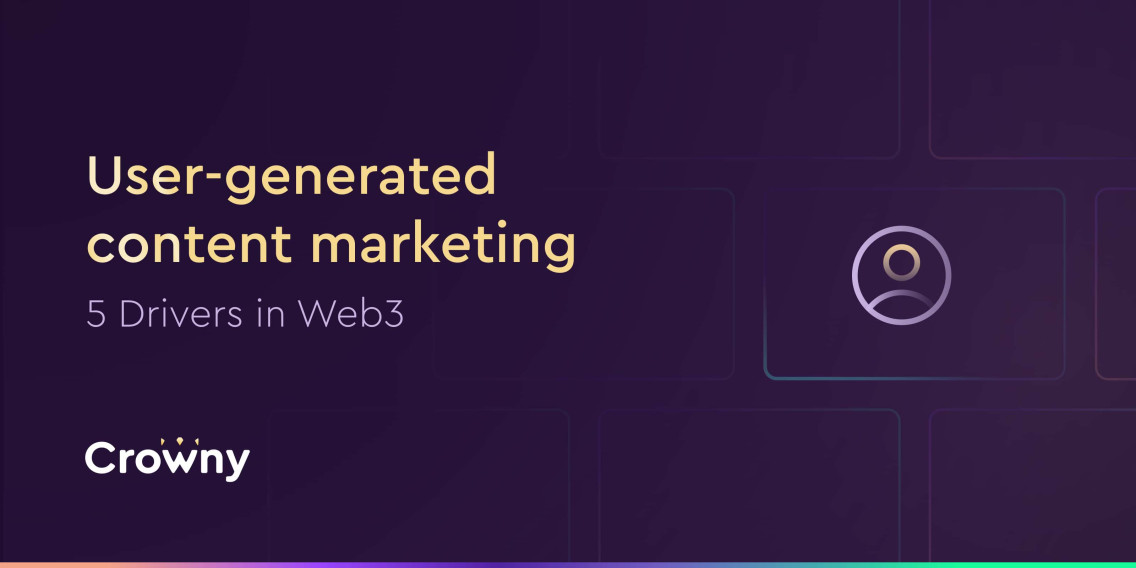User-generated content marketing takes on a new level of significance with Web3. Discover more on increasing effectiveness, key drivers and how to benefit.
Table of contents
Definition of user-generated content marketing
User-generated content (UGC) refers to any form of content, such as text, images, videos, or reviews - created and shared by individuals rather than by the brand or company itself. By tapping into the creativity and passion of their community, brands can harness the potential of UGC to build stronger connections, amplify their reach, enhance their customer journey and drive meaningful engagement. User-generated content marketing refers to a marketing strategy that involves leveraging content created by individuals. A user-generated campaign can be an incredibly effective marketing method when executed well.
User-generated content statistics
To fully grasp the power of this marketing method, take a look at these astonishing user-generated content statistics that highlight the effectiveness of user-generated content:
☑️User-generated content (UGC) is proven to be 35% more memorable compared to content created by professional marketers☑️An astounding 79% of people claim that UGC has a significant influence on their purchasing decisions☑️When it comes to making purchasing decisions, 74% of consumers heavily rely on social media for guidance☑️Social media campaigns that incorporate UGC experience a remarkable 50% increase in engagement levels☑️Furthermore, campaigns utilizing UGC generate 29% higher conversion rates compared to those that don't incorporate it☑️Around 70% of brands firmly believe that UGC plays a vital role in establishing better connections with customers on social media☑️Surprisingly, a mere 1% of millennials find traditional brand ads engaging and trustworthy enough to be worth clicking through
Source: Search Logistics
5 key characteristics of user-generated content marketing
As you have now learned, this method can be incredibly powerful. Here are 5 key characteristics of an effective user-generated content campaign:
☑️Building a sense of community☑️Authenticity and trust☑️Active participation☑️Emotional connection☑️Memorable and shareable
Building a sense of community
UGC allows customers to become part of a brand's community, enabling brands to unlock full community marketing potential. The main result is fostering a sense of belonging and connection with the relevant audience. By actively involving customers in the content creation process, brands create a space where customers can engage with one another and feel like they are part of something greater than themselves.
Authenticity and trust
UGC is inherently authentic as it is created by real customers who have experienced the brand's products or services. This authenticity resonates with other consumers and builds trust. When potential customers see UGC they perceive it as genuine and reliable, which can significantly influence their purchasing decisions.
Consumers find UGC 9.8x more impactful than influencer content when making a purchasing decision. (Stackla)
Active participation
UGC campaigns encourage active participation from customers, leading to higher levels of engagement. People are more likely to engage with UGC because it reflects their own experiences, opinions, and creativity. This increased engagement can extend the reach of the campaign as customers share their UGC with their own networks.
Emotional connection
UGC has the power to evoke emotions in consumers. When customers see others enjoying a brand's products or services, they can relate to those positive experiences, triggering emotional connections and a desire to be part of that experience as well. This emotional resonance can lead to increased brand loyalty and affinity.
Memorable and shareable
UGC is often memorable due to its authenticity and unique perspectives. Customers are more likely to remember UGC compared to traditional marketing content. Additionally, UGC is highly shareable. It allows customers to spread the brand's message organically within their own networks, enabling enhanced omnichannel marketing.
User-generated content marketing examples
UGC can manifest in various ways, including customer reviews, social media posts, blog comments, and even user-generated campaigns. Let's take a look at some cool examples:
Starbucks
Back in 2014, Starbucks kicked off an awesome campaign called #WhiteCupContest. They asked customers to get creative and draw on their white cups, with the chance of having their designs featured in future cup designs. It was a big hit and gave people a unique chance to show off their artistic skills on Starbucks' ceramic ware.
Calvin Klein
Fashion brands have found tremendous success with UGC campaigns. Calvin Klein, for example, revived its iconic tagline "Nothing comes Between Me and My Calvins" and asked customers to share their own #MyCalvins stories on Instagram. The response was overwhelming, with over 190,000 tagged photos in just a few months.
GoPro
Instagram is teeming with stunning user-generated content, especially under the popular hashtag #GoPro. With close to 50 million posts, it's evident that GoPro cameras are the go-to choice for adventure enthusiasts seeking to share their epic experiences with the world.
These are all great campaigns, but not all brands have the pulling power that Starbucks, Calvin Klein or GoPro have. Some audiences need a little more encouragement. Good news: the Web3 creator economy is coming. The advent of Web3 comes with a wave of opportunities for businesses of any size.
5 drivers of user-generated content marketing in Web3
With the advent of Web3, the role of UGC has taken on a whole new level of significance. UGC is a natural fit for the decentralized nature of web3, where creators are empowered to take ownership and control. Time to explore the five key drivers that fuel the effectiveness of user-generated content marketing in the Web3 era.
5 drivers of user-generated content marketing in Web3:
☑️Community empowerment☑️Decentralization and authenticity☑️Incentivization and tokenization☑️Amplified reach and engagement☑️Data-driven insights
Community empowerment
Web3 platforms have the ability to empower online communities by providing a platform for engagement and collaboration. With Crowny's loyalty program software, for example, brands can create their own in-app loyalty program. They can also launch incentive-driven content campaigns following the interact-to-earn model, allowing their community members to actively participate, contribute and earn. This fosters a sense of ownership and loyalty, ensuring app users stay engaged within the loyalty loop and frequently return to participate in the brand’s initiatives.
Decentralization and authenticity
Within Web3, businesses embrace the decentralized nature to promote authenticity. By leveraging user-generated content, brands using Crowny's software can tap into the genuine experiences and perspectives of their community members. This authenticity builds trust and strengthens the brand-customer relationship, leading to increased customer loyalty and advocacy. It’s the right fit for brands that are looking to improve their relationship marketing methods.
Incentivization and tokenization
By offering rewards and tokens for interacting with user-generated content, brands can leverage their own tokenized economies to motivate their community members to actively contribute and engage. It provides the ideal incentives for engaged customers, ultimately creating a vibrant ecosystem of content creators and enhancing the overall value of the program. Crowny's Web3 loyalty programs include incentivization and tokenization, aligning with the Web3 ethos.
Amplified reach and engagement
By leveraging a mobile-first loyalty program, app users become more active. As app users create and share content related to a brand, it extends the brand's reach to their personal networks. This organic word-of-mouth marketing not only generates higher levels of user engagement but also attracts new customers to join the loyalty loop. With Crowny's content distribution capabilities, brands can amplify their reach and engagement by leveraging user-generated content. By leveraging Web3 features like the one Web3Auth offers, entering this environment becomes easy for everyone.
Data-driven insights
By analyzing user-generated content and engagement patterns, brands can gain deep insights into customer behavior, preferences, and trends. This data-driven approach enables brands to optimize their marketing strategies, tailor their offerings, and provide personalized experiences, enhancing customer satisfaction and loyalty. Crowny's loyalty program software provides brands with valuable data-driven insights while keeping trustworthiness into account by using opt-in consent mechanisms.
Get UGC for your brand
We enable businesses to tap into the potential of UGC within the Web3 creator economy through our rewards program software, including blockchain-based loyalty rewards.
Interested? Get early access to a demo now.

